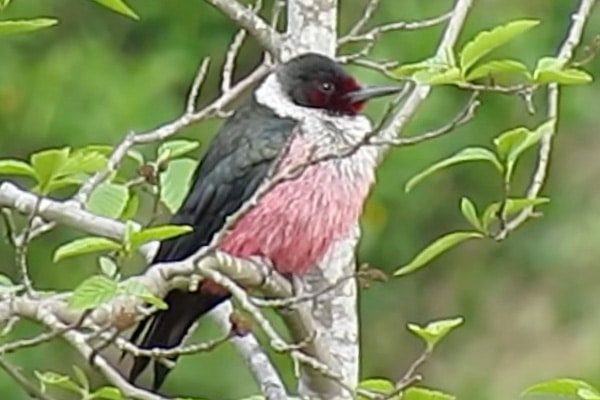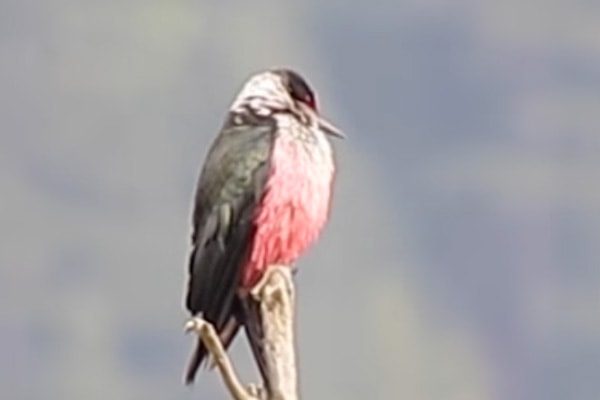Contents
- Lewis’s woodpecker facts
- Lewis’s woodpecker: how-to identify
- Where You’ll See Lewis’s Woodpeckers
- Lewis’s woodpecker diet
- Lewis’s woodpecker nesting
- Lewis’s woodpecker behavior
- How-to attract lewis’s woodpeckers
- Lewis’s woodpecker threats
- Lewis’s woodpecker fun & interesting facts
- Lewis’s woodpecker related species in this family
Lewis’s Woodpeckers are known to be one of the larger woodpecker species. Despite being named a woodpecker, these birds don’t seem to act like one. They feed by catching insects on flight and fly like a crow.
Even their color is different from what you’d usually see on other woodpeckers, mainly featuring a pink belly, gray collar, and dark-green back.
In this article, we will learn more about Lewis’s Woodpeckers. We’ll discuss:
- How to identify them
- Where you’ll find them
- What they eat
- How they nest
- Their behaviors
- How to attract them
- Their conservation status
- Interesting facts
So if you want to learn more about these birds, read on as we go through all bird facts…

Lewis’s woodpecker facts
- Common Name: Lewis’s Woodpecker
- Scientific Name: Melanerpes lewis
- Scientific Family: Picidae
- Life Span: 10 years
- Size: 10.2 to 11.0 inches
- Wingspan: 19.3 to 20.5 inches
- Weight: 3.1 to 4.9 oz
- Conservation status: Near Threatened (NT)
Lewis’s woodpecker: how-to identify
Lewis’s Woodpecker is one of the larger-sized woodpeckers, growing about 10.2 to 11.0 inches in length, 3.1 to 4.9 ounces in weight, and with a wingspan of 19.3 to 20.5 inches.
These birds are easily identifiable with their unique color pattern – gray collar, red chest, black back, black wings, blacktails, and red face. Even if it’s not winter, you would think that snow has covered a part of their body, and from a distance, you might even mistake them as black-colored birds overall.
Differences Between Male & Female
From the first look, you won’t notice any difference between a male Lewis’s woodpecker and its female version. But if you try to look closely and place these birds side by side, male Lewis’s woodpecker is usually larger than the females.
Differences In Summer Plumage vs Winter Plumage
Lewis’s Woodpeckers look the same throughout the year, regardless of the changing seasons.
Where You’ll See Lewis’s Woodpeckers
Lewis’s Woodpeckers are generally found in the western part of the United States, mainly in parts of California, Oregon, Nevada, Utah, Washington, Montana, Idaho, Wyoming, Colorado, New Mexico, and Arizona. They can also be found in the south, but it’s very uncommon.
These birds typically breed in open pine forests and burned forests with many standing dead trees. Sometimes, they might go into woodlands where there’s a body of water and some oak and orchards.
Lewis’s woodpecker bird migration
Lewis’s Woodpeckers are resident to short-distance migratory birds. Generally, populations in the north travel down south for winter, while those in the south move short distances or stay-put. Most of the time, the decision of southern populations whether to stay or go relies on the abundance of food.
Lewis’s woodpecker diet
Like many woodpeckers, a Lewis’s Woodpecker’s diet is generally composed of fruits, nuts, and insects.
One-third of their diet mainly consists of acorns, and with their hoarding instincts, they mainly store these in cracks and bark furrows. And unlike most woodpeckers that would probe trees for wood-boring insects, these birds eat insects they can catch midair or find in tree crevices.
The bird also eats wild berries, including cherries, apricots, pine nuts, etc.

Lewis’s woodpecker nesting
- Clutch Size: 5-9 eggs
- # of Broods: 1 brood
- Incubation Period: 12-16 days
- Nestling Period: 28-34 days
- Egg Description: Opaque white
Lewis’s Woodpeckers mainly prefer to nest cottonwood, paper birch, pine, and a lot more decaying trees. They primarily build their nest in holes made by other woodpeckers or natural crevices of dead and decaying trees and rarely excavate their own.
Lewis’s woodpecker behavior
Lewis’s Woodpeckers love the hot sunshine in summer. They would often spend their days sitting on top of tall dead trees, watching the air for insects.
They are known for their ability to catch insects midair. And when you see them flying, you might mistake them as crows. These birds have languid and steady motions, which are very playful and smooth.
When the cold season comes, the birds shift to eating acorns and other nuts, which they store in burrows or tree crevices.
During this time, they can be very protective of their storage area. When an intruder enters, they will immediately be in a defensive stance to protect their cache, especially for Red-headed Woodpeckers.
How-to attract lewis’s woodpeckers
Lewis’s Woodpeckers don’t visit backyard feeders frequently. In fact, they are still relatively uncommon in some areas where they live.
However, if you do want to attract them, you can use the same techniques generally used to attract woodpeckers:
- Leave a dead tree standing to encourage nesting (but make sure it’s safe to do so)
- Plant tall trees they can perch on when looking for something to eat
- Plant fruit-bearing or nut-bearing plants around you to provide food
- Hang some bird feeders filled with nuts
- Hang suet for winter
- Provide water
And that’s mainly it.
There’s no guarantee that you’ll be able to attract these birds specifically as they don’t often visit crowded places, but it would help you attract other woodpeckers around your area.
Lewis’s woodpecker threats
Lewis’s Woodpeckers are placed on the yellow watch list because of their declining population. It’s found that their population has declined by 72% between 1970 to 2014 and could be ongoing until now.
One of the reasons found for these birds’ decline is the continuous changing of forests conditions. This includes fire, grazing, logging, and even climate change.
Lewis’s woodpecker fun & interesting facts
- Lewis’s Woodpecker rarely digs into trees for wood-boring insects. Instead, they just take insects from the bark or catch flies in the air.
- Alexander Wilson described these birds in 1811.
- They were named after Meriwether Lewis, who first saw the bird in 1805.
- They are poorly monitored in many parts of their range.
- Williamson’s Sapsucker
- Yellow-bellied Sapsucker
- Red-naped Sapsucker
- Red-breasted Sapsucker
- Red-headed Woodpecker
- Acron Woodpecker
- Gila Woodpecker
- Golden-fronted Woodpecker
- Red-bellied Woodpecker
- American Three-toed Woodpecker
- Black-beaded Woodpecker
- Downy Woodpecker
- Nuttall’s Woodpecker
- Ladder-backed Woodpecker
- Red-cockaded Woodpecker
- Hairy Woodpecker
- White-headed Woodpecker
- Arizona Woodpecker
- Ivory-billed Woodpecker
- Pileated Woodpecker
- Northern Flicker
- Gilded Flicker

